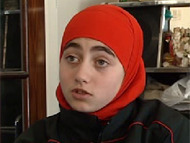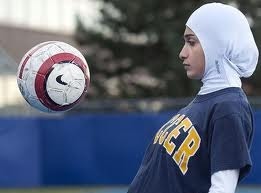The Hijab on the Pitch
The decision came one day after the International Football Association Board — the body within FIFA that governs the laws of the game — unanimously declared that it would, for a “trial period” allow players to wear the hijab during international competitions. France, then, is seeking to carve out an exception to an international ruling, one that links it’s football regulations to a broad set of laws that ban veils in public schools and public administration, as well as banning the burqa in all public spaces. (The hijab covers the hair and neck; generally the term “veils” is used to describe coverings that also cover part of the face, though the usage varies quite a bit; and burqa covers the entire face).
Scholars including Joan Scott and John Bowen have analyzed the history of these broader debates in rich detail, tying them both to longer colonial histories and contemporary battles over the secularism, Islam, and immigration in France. The banning of the hijab from the football pitch was initially a relatively minor subplot in these broader battles over veils, hijab, and burqas in Europe and Canada. But the involvement of FIFA, the Iranian government, a Jordanian Prince and the United Nations have helped to transform the terrain of football into an increasingly important battleground over the hijab.
This week’s announcements are the latest twist that began in 2007. In that year, in Quebec, a referee at Under-12 girl’s soccer tournament ordered an 11-year-old player named Asmahan Mansour (pictured below) to remove the hijab she was wearing during play. She refused, and was told she would have to leave the field. As Mansour later explained simply: “I think it’s pathetic, really, ’cause it’s [the head scarf] tucked in my shirt.”
In a powerful — but since little-reported — show of solidarity, her entire team along with four others playing in the tournament protested, refusing to continue playing unless Mansour was allowed to play. Their instant reaction to the decision speaks volumes. To them, it seems, Mansour’s hijab was a normal and unproblematic part of their daily lives as players, and the insistence that she remove seemed it an intolerable intervention — one they were so insulted by that they preferred to forfeit than accept it.
Part of the reason for the strong reaction the girls had to the referee’s intervention is that Quebec’s position was at odds with that of other regions of Canada. In Ontario, for instance — and in Ottawa, where Mansour was from — officials and referees had allowed girls to wear the hijab as long as it was properly tucked into clothing so as not to present a hazard on the field. But the intervention on the football pitch was part of a broader pattern in Quebec, which like France has banned the burqa in all public spaces.
In the wake of the incident FIFA took up the question of whether the hijab should be allowed. They concluded that the referee in Quebec had been right: the hijab was pronounced a danger to the safety of players. To me, at least, this argument has always seemed like it would collapse under the weight of it’s own absurdity. After all, long hair is more likely to get pulled or tangled in play. And one could ask: if wearing something that covers your head poses a danger to players, then why is Petr Cech allowed wear one in every match (including international competition) — to protect his head? (Cech’s head-gear serves to protect his skull in the wake of an injury received during play, and obviously is not the same as a hijab in structure; the point is just that the idea that a head-covering is dangerous seems a hard to sustain). I would argue that the safety argument has, from the beginning, served largely as a pretext for the cultural struggles at work in this debate. It would never have been difficult to develop the sort of hijab that are now widely used, which attach closely to athletes heads to avoid the possibility they will get somehow get caught or pulled off during play in a dangerous way.
FIFA’s decision only applied to international competitions: national federations could make their own decision about the issue when it came to the competitions they oversaw. But since women who refused to play without a hijab were effectively banned from international competition, national federations effectively had to discriminate against such players in composing their highest-level teams. As significantly, with this ruling FIFA became the first global international organization to take up the question of the hijab. (The broader legal implications of this were explored nicely in this interview with legal scholar Linda Sheryl Greene.) The European Union Court had, on previous occasions, upheld the banning of hijab in both France and Turkey, rebuffing legal activists who claimed they were violations of human rights. But the United Nations had never, to my knowledge, taken up the issue. So FIFA’s decision took on a kind of symbolic importance that the members of the organization had perhaps not expected it would.
And in time, the fact that FIFA is truly global in scope is what ultimately led to the overturning of the 2007 decision. For especially given the increasing prominent of Middle Eastern countries, North Africa, and Asian countries with large Muslim populations within both global football and FIFA, the association began an ideal site for political pressure against the banning of hijab, which has never yet been successful in reversing such bans in Europe or Canada.
Like the girls in Quebec who walked off the field in 2007, many players have supported the rights of teammates to play with a hijab. Players throughout the Middle East have been doing so for decades in a variety of contexts. The global player’s organization FIFPro came out in support of lifting the ban on veils, for instance. The organization Right2Wear has been advocating at the grassroots for women’s right to wear headscarves while playing football. But such organizations on their own probably would not have had the clout to reverse FIFA’s decision.
In 2011, however, FIFA officials stopped the Iranian national women’s team from playing in an Olympic qualifying game because their players were wearing hijab. The team was literally minutes from entering the field when they were told they could not play, though FIFA later claimed that the Iranian federation had been warned in advance they would not be allowed to play. Interestingly, during that incident FIFA justified the ban on hijab on the basis of regulations that outlaw the presence of “politics or religion” on uniforms, not based on the safety dangers cited in 2007. Iranian President Mahmoud Ahmadinejad attacked FIFA, referring to them as “dictators” and “colonialists,” while the Iranian ambassador to Jordan referred to the leaders of the international footballing organization as “extremists.”
As FIFA cynics pointed out at the time, the organization was perhaps the only one in the world capable of making Ahmadinejad sympathetic to a broader global consituency — especially on the issue of women’s rights. If Iran had been on it’s own in confronting FIFA, they might not have made much headway. But many other countries began mobilizing to criticize the ban. Jordan’s Prince Ali Bin Al Hussein took up the cause, and in March 2012 insisted that FIFA should overturn the ban. (Jordan’s national women’s team had been forced not to select certain players for international competition because they wished to wear the hijab when they were playing.) And United Nations sports advisor wrote to FIFA also urging them to lift the ban, arguing that “FIFA has the responsibility to ensure that everyone has an equal chance to participate in football.”
In March of this past year, FIFA voted to end the ban and allow players on the pitch in new, specially-designed, velcro-fastened, hijab. Besides spurring on the creation of a whole new branch of athletic wear — one can imagining smiling Nike and Adidas executives reading the news — this was a significant reversal.
It was, however, still tentative, for the issue of the safety of the hijab was still to be taken up by medical specialists at FIFA. Finally, Thursday, a full — if still temporary — approval of the hijab in international women’s play has been passed by FIFA, prompting much celebration in some quarters, and the immediate refusal of the principle by the French Football Federation.
There will, undoubtedly, be more twists and turns to this issue. Globally, the hijab has become a crossroads for political and religious conflict, and it should come as no surprise that this is true in football too. Yet there is something fascinating about this struggle over the right to play football in a hijab because of the nub of contradictions at work here. The French and Quebecois authorities, and FIFA, who banned the hijab did so for various reasons: they sometimes evoked worries about safety, but underlying their decisions was the idea that they were in effect protecting women from the veil, or else protecting the turf from expressions of worn Islamic religious identification. Those who have insisted that women and girls be allowed to play wearing the hijab have argued that to deny them this right is an attack against their freedom and equality. For the moment, the latter argument has — at least tentatively — won the day. That is a victory for the many women and girls who will have renewed access to the field of play. Through their very presence in that space, they can help to confront and unwind the many misunderstandings surrounding the hijab. More importantly, they will be able to play the game they love.
Laurent Dubois's Blog
- Laurent Dubois's profile
- 44 followers





